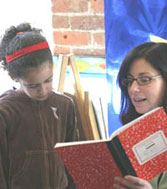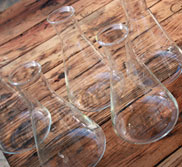 "Do all your eating at a table. No, a desk is not a table.”
"Do all your eating at a table. No, a desk is not a table.”
Guilty.
Ted says the illustration above is of me. It's not, but it could be.
How many food rules do you break? Michael Pollan has added 19 new rules in his latest book, Food Rules: an eater's manual, and they’ve been brought to life by the fabulous illustrations from artist, Maira Kalman.
I just read an interview with Michael Pollan by writer, Sarah Henry of Civil Eats. The interview digs into how his collaboration with Kalman came to be. When asked during the interview whether or not Pollan feels our interest in the food movement has peaked, he expanded upon why he keeps pushing food:
“I do feel a sense of urgency to keep writing about food. We’re just beginning to see the impact of our food choices on health care and insurance costs—obesity, diabetes, and heart disease are soaring—and we need to keep the pressure on the government and corporations for change.” 
I mostly like Pollan’s rules and abide by this one:
“Eat food. Not too much. Mostly plants.”
This rule has been my food mantra for years:
"The fewer the feet, the better the meat”
…minus the feet.
More and more I’m noticing that I have conflicting issues around food--but they're the opposite problem than those who eat too much meat have. For years, my family has chided me to loosen up on my no red meat rule. Friends I’ve known my entire life can’t seem to remember that I haven’t eaten red meat since college. When I'm invited to dinner, they still ask,
“What is it again that you don’t eat?”
Why don’t I eat red meat? I can’t remember. I do know I’ve lost my taste for it. A part of me wishes I could find a reason to bring a little meat back into my diet because I’m getting increasingly paranoid about all the mercury in fish. I'm told, the cute cows I can hear mooing from the farm behind my backyard are the best meat around.
I want to live the life of a locavore. Yet, I can’t eat red meat...and I can’t remember anymore why I hold on tight to that food rule.
Pollan says to those who want to know if they need food rules:
“When you eat real food, you don’t need rules.”
Oh no, this one doesn’t fly with me because I have food rules and I eat real food. Anyone else have this food rule backlash problem?
Food issues are complicated, and the act of eating should be part pleasure, part communion with a hefty dose of healthy nutrition.
Maira Kalman’s illustrations are poignant, funny and sad all at the same time, which just about sums up my latest food feelings. Her art adds a large dollop of cream to Pollan’s book.
http://youtu.be/fugCMaPp0mY
If you’re in mood for a little humor, Pollan brings his food rules to Stephen Colbert’s plate. Watch the funny exchange here.
Main image: Maira Kalman for Food Rules







